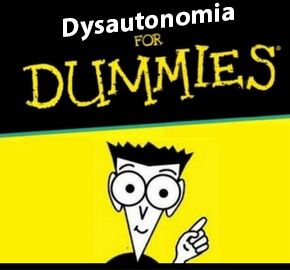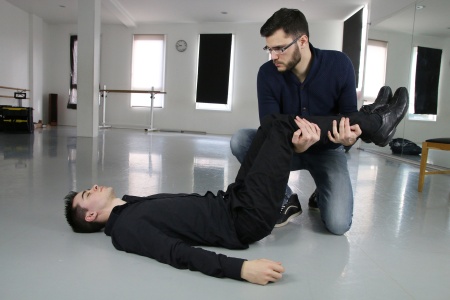I’m Evie and I come from Cork, Ireland. I’m a 29-year-old mother of two baby zebras. Alex is 7 and Olivia is almost 2. I am diagnosed with Hypermobile Ehlers Danlos Syndrome (hEDS), Orthostatic Intolerance and Vasovagal Syncope. I first heard of EDS after interviewing a young woman with EDS for the paper I used to work for. Something about this woman’s story stirred something inside me and I became passionate about raising awareness of the condition. A year later I was diagnosed with EDS. When I’m not blogging, looking after my two children or lying in bed ill, I help my husband run our wedding videography business and co-host a radio show on Saturday evenings from 7pm (Irish time) on www.clonlineradio.com.

I write about Ehlers Danlos Syndrome an awful lot and with where I am guest posting today, I decided to focus on Dysautonomia. I recently wrote A Simple Guide to EDS on my own blog so now I’m going to write A Simple Guide to Dysautonomia. I hope that this blog will help people to understand the complexity of Dysautonomia; if they are newly diagnosed or want to help their loved ones understand. I have omitted a lot of medical jargon and used easy to understand language so this can also be accessible to young people.
What is Dysautonomia (DIS AUTO NOMIA)?
The Autonomic System is the system in the body responsible for every automatic thing your body does. It is responsible for the way you breathe, the way your heart beats, the way your blood pumps around your body, the way you digest your food and even the way your contractions work in child birth. The Autonomic System is very important.
So, when your Autonomic System doesn’t work correctly this is known as Dysautonomia. Dys simply means “bad”, “ill” or “abnormal”. Dysautonomia is a general term for any condition that disrupts any aspect of the autonomic system.
What causes Dysautonomia?
This is a complicated question. There are many, many reasons why Dysautonomia occurs. It can be the result of other conditions, for example it is believed that Ehlers Danlos Syndrome (AY-LERZ-DAN-LOSS-SIN-DROME) is responsible for Dysautonomia in some patients but that hasn’t been officially confirmed. It can be induced in pregnancy, can be inherited or can occur when the autonomic system has been damaged. Even being deficient in certain vitamins can trigger Dysautonomia.
How does Dysautonomia affect people?
Depending on the type of Dysautonomia you have, the symptoms vary. One of the most common types of Dysautonomia is Postural Orthostatic Tachycardia Syndrome. That’s a mouthful, right? Most people just call it POTS for short.
POTS basically means that when you are in an upright position your heart beats faster than it should (at least 30 beats faster than when a person is lying down or sitting). This can make people feel very ill. POTS can cause people to faint when they’re upright or exercising, they can also get very bad headaches, have chronic fatigue (being tired all the time) or find it difficult to sleep. A big sign of POTS is red or blue coloured skin in the legs and feet when they’re standing or sitting. This shows that their blood is having trouble pumping around their body and is gathering in the legs and feet. This is often the reason why people get dizzy and faint.
Another common type of Dysautonomia is Orthostatic Intolerance (OI). OI means in the simplest term that your body does not like being upright. Almost like you’re allergic to standing up. Some people with POTS also have OI. The symptoms of OI include palpitations (your heart pounding very hard), light-headedness, chest pain, trouble breathing, nausea, brain fog (trouble thinking or speaking coherently) and fainting.
Exercise, heat, alcohol or even eating a large meal can bring on symptoms of these conditions.
Other types of Dysautonomia include Vasovagal Syncope and Neurocardiogenic Sycope (NCS). These conditions also display similar symptoms.
How is Dysautonomia diagnosed?
If you’re experiencing symptoms of Dysautonomia, the first port of call is to discuss your symptoms with your doctor. Unfortunately, medical professionals fob off quite a lot of people. Patients are told they just need to get more sleep or exercise more.
If you do think you may have Dysautonomia, do suggest the possibility to your doctor. Like any other human, they won’t be able to remember everything they learned in college. You may just see a light bulb going off, and find that your doctor is suddenly able to help. Once a doctor focuses on the possibility, they should take a detailed medical history and perform a careful physical exam.
If your doctor is unwilling to take the possibility of Dysautonomia seriously, consider seeing another doctor. Patients lucky enough to be taken seriously by their family doctors are likely to be referred to a specialist.
The type of specialist you will be referred to usually depend on the predominant symptom they are experiencing. The specialist will then decide on what tests you need and then come up with a plan to help you treat and manage your symptoms.
Can you tell someone has Dysautonomia just by looking at them?
No. Dysautonomia is considered to be an invisible condition. Even though you can’t see it, it still exists. It is a disability and should be treated like any other visible disability. To a trained eye, Dysautonomic signs can be spotted like the pooling in the legs and feet like we discussed earlier.
Can Dysautonomia kill people?
Generally? No. There is a type of Dysautonomia called Multiple System Atrophy (MSA) that is fatal. It has symptoms vey similar to Parkinson’s disease, but has quicker progression. People with MSA are rare and the condition usually occurs in adults over the age of 40. The cause of MSA is unknown, and no cure or treatment slows the disease.
But generally, unless you fainted and hit your head or fell from a height, you won’t die from your symptoms. However, many people have a very poor quality of life due to the severity of their condition.
What treatments are available for people with Dysautonomia?
Luckily, most people can manage their symptoms with prescription medications given by their doctor. A common medicine known as a vasoconstrictor can stop the heart beating too fast and the blood pressure dropping too low. While these medications can help relieve the symptoms of the heart problems, it does not solve the underlying issue causing Dysautonomia. Sometimes medications can make things worse or cause new symptoms.
Dysautonomia is generally considered a progressive disease, which means it gets worse over time. When the Autonomic Nervous System becomes unregulated it can begin causing damage to the organs. For example, some people suffer from a condition called Gastroparesis (GAS-TRO-PAR-EE-SISS). This causes the stomach and intestines to become paralysed. This means food often sits in the stomach and digestive system for too long. This means that people with the condition can be very ill. Some of them even need to be fed with a tube. This is why early diagnosis is important.
Treating Dysautonomic symptoms can be very tricky because there can be a huge range of symptoms. Some people will have to take different types of medications to treat all the different symptoms.
Luckily, there are some new treatments becoming available but they can be difficult to access, especially in Ireland where there are no Dysautonomia specific specialists or clinics.
I know someone with Dysautonomia who uses a wheelchair. Do all people with Dysautonomia need wheelchairs?
No. Not everyone who suffers from Dysautonomia needs to use a wheelchair. Some people have symptoms so bad that they need to use the wheelchair for their own safety just in case they faint and hurt themselves. Other people use wheelchairs sometimes when they are having a bad day with their symptoms. Some people with Dysautonomia have other conditions like EDS which means they have even more trouble with their body like chronic pain (pain all the time) or they are susceptible to dislocations (their joints pop out of their sockets). They may need the wheelchair to get around.
Some people don’t use wheelchairs at all; they may use a stick or not use anything at all. It varies from person to person.
Can you catch Dysautonomia?
No. Dysautonomia is not contagious. If you know somebody with Dysautonomia, don’t be afraid, you’re not going to catch anything from him or her. So, if you’re avoiding someone with a type of Dysautonomia, go make friends with him or her.
How can I help someone with Dysautonomia?
Be there to listen if they want to talk about it. Some people are afraid to tell you how they feel because they think friends and family don’t want to hear them complain. Ask them how they are and if you can do anything to help them. Doing shopping or household chores can be a huge help and it would be most appreciated. If you’re friend or family member has Dysautonomia and can’t access appropriate treatment like here in Ireland, write to your local representatives to tell them about Dysautonomia and the lack of care that is available. Help raise awareness in the public by sharing articles or pictures about Dysautonomia. Dysautonomic conditions are incredibly under diagnosed and many of the tests needed to diagnose some of the conditions are not available here in Ireland.
If someone with a type of Dysautonomia that makes them faint collapses in front of you:
– position them on their back. If the person is breathing restore blood flow to the brain by raising their legs above the heart level. Loosen anything they are wearing that might be tight or restrictive. Usually someone with a fainting disorder will come to without any further problems. Give them a glass of water and when they’re ready, help them up slowly. If they are not ready to get up, sit or lie down with them.
It can be embarrassing to faint sometimes so it’s nice to have someone lie down and chat with you to make you feel better. Fainting can be very disorientating and the person may also be sore so let them rest. If you’re worried that they may have broken something or banged their head hard, take them to the hospital or out of hours doctor to get checked out. If the person does not come to, starts seizing or stops breathing call 999 or 112.-
Well, I hope that I’ve explained Dysautonomia in an accessible way and that it is worthy of a share.
You can find more of my blogs on my own website, The Zebra Mom You can also follow me on Facebook, Twitter, Instagram, Pinterest and Snapchat (evienevin87).
_____________________________________________________________________________
Thanks so very much to Evie from The Zebra Mom for doing a Saturday Submissions blog for us and a very appropriate post it is too. Do you have any further questions in relation to Dysautonomia for Evie or myself? Please leave a comment below and tell us what you think!
——— Wanna Be Part of Saturday Submissions?———-
All you have to do is tell us a little about yourself and write a blog post in relation to your chronic illness, all welcome!
You can include photos (preferably your own, if found online be sure to add links to where you found them)
Be sure to add links to your social media accounts so people can link back to you OR You can write it anonymously if you like 🙂
You can send your submissions to: irishpotsies@gmail.com
——————————————-


